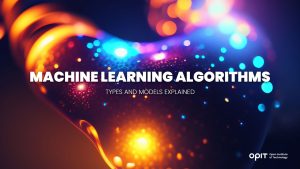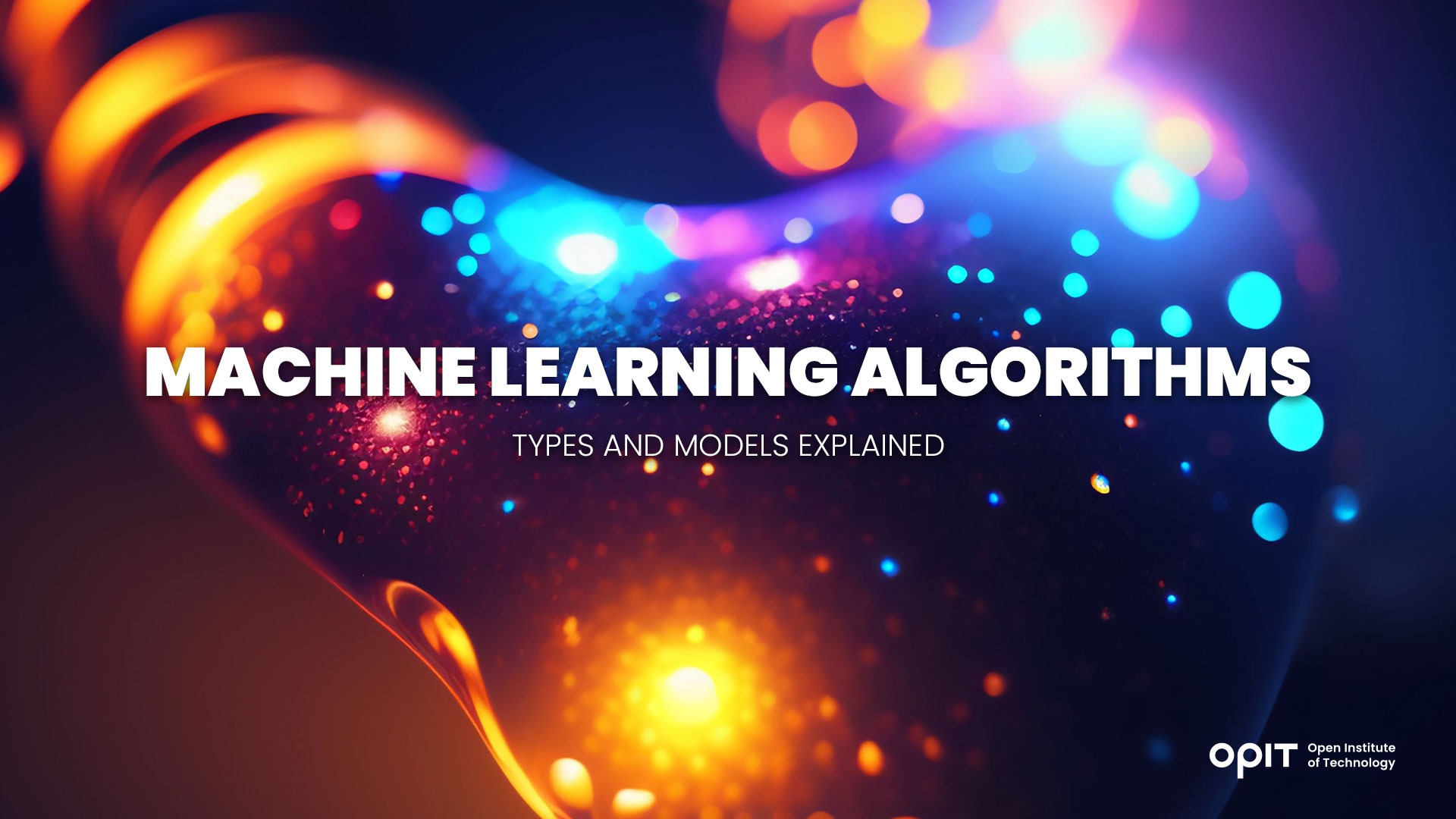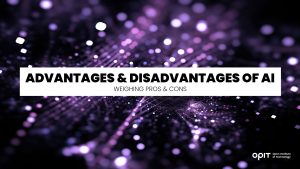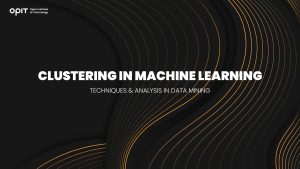

Any tendency or behavior of a consumer in the purchasing process in a certain period is known as customer behavior. For example, the last two years saw an unprecedented rise in online shopping. Such trends must be analyzed, but this is a nightmare for companies that try to take on the task manually. They need a way to speed up the project and make it more accurate.
Enter machine learning algorithms. Machine learning algorithms are methods AI programs use to complete a particular task. In most cases, they predict outcomes based on the provided information.
Without machine learning algorithms, customer behavior analyses would be a shot in the dark. These models are essential because they help enterprises segment their markets, develop new offerings, and perform time-sensitive operations without making wild guesses.
We’ve covered the definition and significance of machine learning, which only scratches the surface of this concept. The following is a detailed overview of the different types, models, and challenges of machine learning algorithms.
Types of Machine Learning Algorithms
A natural way to kick our discussion into motion is to dissect the most common types of machine learning algorithms. Here’s a brief explanation of each model, along with a few real-life examples and applications.
Supervised Learning
You can come across “supervised learning” at every corner of the machine learning realm. But what is it about, and where is it used?
Definition and Examples
Supervised machine learning is like supervised classroom learning. A teacher provides instructions, based on which students perform requested tasks.
In a supervised algorithm, the teacher is replaced by a user who feeds the system with input data. The system draws on this data to make predictions or discover trends, depending on the purpose of the program.
There are many supervised learning algorithms, as illustrated by the following examples:
- Decision trees
- Linear regression
- Gaussian Naïve Bayes
Applications in Various Industries
When supervised machine learning models were invented, it was like discovering the Holy Grail. The technology is incredibly flexible since it permeates a range of industries. For example, supervised algorithms can:
- Detect spam in emails
- Scan biometrics for security enterprises
- Recognize speech for developers of speech synthesis tools
Unsupervised Learning
On the other end of the spectrum of machine learning lies unsupervised learning. You can probably already guess the difference from the previous type, so let’s confirm your assumption.
Definition and Examples
Unsupervised learning is a model that requires no training data. The algorithm performs various tasks intuitively, reducing the need for your input.
Machine learning professionals can tap into many different unsupervised algorithms:
- K-means clustering
- Hierarchical clustering
- Gaussian Mixture Models
Applications in Various Industries
Unsupervised learning models are widespread across a range of industries. Like supervised solutions, they can accomplish virtually anything:
- Segment target audiences for marketing firms
- Grouping DNA characteristics for biology research organizations
- Detecting anomalies and fraud for banks and other financial enterprises
Reinforcement Learning
How many times have your teachers rewarded you for a job well done? By doing so, they reinforced your learning and encouraged you to keep going.
That’s precisely how reinforcement learning works.
Definition and Examples
Reinforcement learning is a model where an algorithm learns through experimentation. If its action yields a positive outcome, it receives an award and aims to repeat the action. Acts that result in negative outcomes are ignored.
If you want to spearhead the development of a reinforcement learning-based app, you can choose from the following algorithms:
- Markov Decision Process
- Bellman Equations
- Dynamic programming
Applications in Various Industries
Reinforcement learning goes hand in hand with a large number of industries. Take a look at the most common applications:
- Ad optimization for marketing businesses
- Image processing for graphic design
- Traffic control for government bodies
Deep Learning
When talking about machine learning algorithms, you also need to go through deep learning.
Definition and Examples
Surprising as it may sound, deep learning operates similarly to your brain. It’s comprised of at least three layers of linked nodes that carry out different operations. The idea of linked nodes may remind you of something. That’s right – your brain cells.
You can find numerous deep learning models out there, including these:
- Recurrent neural networks
- Deep belief networks
- Multilayer perceptrons
Applications in Various Industries
If you’re looking for a flexible algorithm, look no further than deep learning models. Their ability to help businesses take off is second-to-none:
- Creating 3D characters in video gaming and movie industries
- Visual recognition in telecommunications
- CT scans in healthcare
Popular Machine Learning Algorithms
Our guide has already listed some of the most popular machine-learning algorithms. However, don’t think that’s the end of the story. There are many other algorithms you should keep in mind if you want to gain a better understanding of this technology.
Linear Regression
Linear regression is a form of supervised learning. It’s a simple yet highly effective algorithm that can help polish any business operation in a heartbeat.
Definition and Examples
Linear regression aims to predict a value based on provided input. The trajectory of the prediction path is linear, meaning it has no interruptions. The two main types of this algorithm are:
- Simple linear regression
- Multiple linear regression
Applications in Various Industries
Machine learning algorithms have proved to be a real cash cow for many industries. That especially holds for linear regression models:
- Stock analysis for financial firms
- Anticipating sports outcomes
- Exploring the relationships of different elements to lower pollution
Logistic Regression
Next comes logistic regression. This is another type of supervised learning and is fairly easy to grasp.
Definition and Examples
Logistic regression models are also geared toward predicting certain outcomes. Two classes are at play here: a positive class and a negative class. If the model arrives at the positive class, it logically excludes the negative option, and vice versa.
A great thing about logistic regression algorithms is that they don’t restrict you to just one method of analysis – you get three of these:
- Binary
- Multinomial
- Ordinal
Applications in Various Industries
Logistic regression is a staple of many organizations’ efforts to ramp up their operations and strike a chord with their target audience:
- Providing reliable credit scores for banks
- Identifying diseases using genes
- Optimizing booking practices for hotels
Decision Trees
You need only look out the window at a tree in your backyard to understand decision trees. The principle is straightforward, but the possibilities are endless.
Definition and Examples
A decision tree consists of internal nodes, branches, and leaf nodes. Internal nodes specify the feature or outcome you want to test, whereas branches tell you whether the outcome is possible. Leaf nodes are the so-called end outcome in this system.
The four most common decision tree algorithms are:
- Reduction in variance
- Chi-Square
- ID3
- Cart
Applications in Various Industries
Many companies are in the gutter and on the verge of bankruptcy because they failed to raise their services to the expected standards. However, their luck may turn around if they apply decision trees for different purposes:
- Improving logistics to reach desired goals
- Finding clients by analyzing demographics
- Evaluating growth opportunities
Support Vector Machines
What if you’re looking for an alternative to decision trees? Support vector machines might be an excellent choice.
Definition and Examples
Support vector machines separate your data with surgically accurate lines. These lines divide the information into points close to and far away from the desired values. Based on their proximity to the lines, you can determine the outliers or desired outcomes.
There are as many support vector machines as there are specks of sand on Copacabana Beach (not quite, but the number is still considerable):
- Anova kernel
- RBF kernel
- Linear support vector machines
- Non-linear support vector machines
- Sigmoid kernel
Applications in Various Industries
Here’s what you can do with support vector machines in the business world:
- Recognize handwriting
- Classify images
- Categorize text
Neural Networks
The above deep learning discussion lets you segue into neural networks effortlessly.
Definition and Examples
Neural networks are groups of interconnected nodes that analyze training data previously provided by the user. Here are a few of the most popular neural networks:
- Perceptrons
- Convolutional neural networks
- Multilayer perceptrons
- Recurrent neural networks
Applications in Various Industries
Is your imagination running wild? That’s good news if you master neural networks. You’ll be able to utilize them in countless ways:
- Voice recognition
- CT scans
- Commanding unmanned vehicles
- Social media monitoring
K-means Clustering
The name “K-means” clustering may sound daunting, but no worries – we’ll break down the components of this algorithm into bite-sized pieces.
Definition and Examples
K-means clustering is an algorithm that categorizes data into a K-number of clusters. The information that ends up in the same cluster is considered related. Anything that falls beyond the limit of a cluster is considered an outlier.
These are the most widely used K-means clustering algorithms:
- Hierarchical clustering
- Centroid-based clustering
- Density-based clustering
- Distribution-based clustering
Applications in Various Industries
A bunch of industries can benefit from K-means clustering algorithms:
- Finding optimal transportation routes
- Analyzing calls
- Preventing fraud
- Criminal profiling
Principal Component Analysis
Some algorithms start from certain building blocks. These building blocks are sometimes referred to as principal components. Enter principal component analysis.
Definition and Examples
Principal component analysis is a great way to lower the number of features in your data set. Think of it like downsizing – you reduce the number of individual elements you need to manage to streamline overall management.
The domain of principal component analysis is broad, encompassing many types of this algorithm:
- Sparse analysis
- Logistic analysis
- Robust analysis
- Zero-inflated dimensionality reduction
Applications in Various Industries
Principal component analysis seems useful, but what exactly can you do with it? Here are a few implementations:
- Finding patterns in healthcare records
- Resizing images
- Forecasting ROI
Challenges and Limitations of Machine Learning Algorithms
No computer science field comes without drawbacks. Machine learning algorithms also have their fair share of shortcomings:
- Overfitting and underfitting – Overfitted applications fail to generalize training data properly, whereas under-fitted algorithms can’t map the link between training data and desired outcomes.
- Bias and variance – Bias causes an algorithm to oversimplify data, whereas variance makes it memorize training information and fail to learn from it.
- Data quality and quantity – Poor quality, too much, or too little data can render an algorithm useless.
- Computational complexity – Some computers may not have what it takes to run complex algorithms.
- Ethical considerations – Sourcing training data inevitably triggers privacy and ethical concerns.
Future Trends in Machine Learning Algorithms
If we had a crystal ball, it might say that future of machine learning algorithms looks like this:
- Integration with other technologies – Machine learning may be harmonized with other technologies to propel space missions and other hi-tech achievements.
- Development of new algorithms and techniques – As the amount of data grows, expect more algorithms to spring up.
- Increasing adoption in various industries – Witnessing the efficacy of machine learning in various industries should encourage all other industries to follow in their footsteps.
- Addressing ethical and social concerns – Machine learning developers may find a way to source information safely without jeopardizing someone’s privacy.
Machine Learning Can Expand Your Horizons
Machine learning algorithms have saved the day for many enterprises. By polishing customer segmentation, strategic decision-making, and security, they’ve allowed countless businesses to thrive.
With more machine learning breakthroughs in the offing, expect the impact of this technology to magnify. So, hit the books and learn more about the subject to prepare for new advancements.
Related posts

Source:
- Agenda Digitale, published on November 25th, 2025
In recent years, the word ” sustainability ” has become a firm fixture in the corporate lexicon. However, simply “doing no harm” is no longer enough: the climate crisis , social inequalities , and the erosion of natural resources require a change of pace. This is where the net-positive paradigm comes in , a model that isn’t content to simply reduce negative impacts, but aims to generate more social and environmental value than is consumed.
This isn’t about philanthropy, nor is it about reputational makeovers: net-positive is a strategic approach that intertwines economics, technology, and corporate culture. Within this framework, digitalization becomes an essential lever, capable of enabling regenerative models through circular platforms and exponential technologies.
Blockchain, AI, and IoT: The Technological Triad of Regeneration
Blockchain, Artificial Intelligence, and the Internet of Things represent the technological triad that makes this paradigm shift possible. Each addresses a critical point in regeneration.
Blockchain guarantees the traceability of material flows and product life cycles, allowing a regenerated dress or a bottle collected at sea to tell their story in a transparent and verifiable way.
Artificial Intelligence optimizes recovery and redistribution chains, predicting supply and demand, reducing waste and improving the efficiency of circular processes .
Finally, IoT enables real-time monitoring, from sensors installed at recycling plants to sharing mobility platforms, returning granular data for quick, informed decisions.
These integrated technologies allow us to move beyond linear vision and enable systems in which value is continuously regenerated.
New business models: from product-as-a-service to incentive tokens
Digital regeneration is n’t limited to the technological dimension; it’s redefining business models. More and more companies are adopting product-as-a-service approaches , transforming goods into services: from technical clothing rentals to pay-per-use for industrial machinery. This approach reduces resource consumption and encourages modular design, designed for reuse.
At the same time, circular marketplaces create ecosystems where materials, components, and products find new life. No longer waste, but input for other production processes. The logic of scarcity is overturned in an economy of regenerated abundance.
To complete the picture, incentive tokens — digital tools that reward virtuous behavior, from collecting plastic from the sea to reusing used clothing — activate global communities and catalyze private capital for regeneration.
Measuring Impact: Integrated Metrics for Net-Positiveness
One of the main obstacles to the widespread adoption of net-positive models is the difficulty of measuring their impact. Traditional profit-focused accounting systems are not enough. They need to be combined with integrated metrics that combine ESG and ROI, such as impact-weighted accounting or innovative indicators like lifetime carbon savings.
In this way, companies can validate the scalability of their models and attract investors who are increasingly attentive to financial returns that go hand in hand with social and environmental returns.
Case studies: RePlanet Energy, RIFO, and Ogyre
Concrete examples demonstrate how the combination of circular platforms and exponential technologies can generate real value. RePlanet Energy has defined its Massive Transformative Purpose as “Enabling Regeneration” and is now providing sustainable energy to Nigerian schools and hospitals, thanks in part to transparent blockchain-based supply chains and the active contribution of employees. RIFO, a Tuscan circular fashion brand, regenerates textile waste into new clothing, supporting local artisans and promoting workplace inclusion, with transparency in the production process as a distinctive feature and driver of loyalty. Ogyre incentivizes fishermen to collect plastic during their fishing trips; the recovered material is digitally tracked and transformed into new products, while the global community participates through tokens and environmental compensation programs.
These cases demonstrate how regeneration and profitability are not contradictory, but can actually feed off each other, strengthening the competitiveness of businesses.
From Net Zero to Net Positive: The Role of Massive Transformative Purpose
The crucial point lies in the distinction between sustainability and regeneration. The former aims for net zero, that is, reducing the impact until it is completely neutralized. The latter goes further, aiming for a net positive, capable of giving back more than it consumes.
This shift in perspective requires a strong Massive Transformative Purpose: an inspiring and shared goal that guides strategic choices, preventing technology from becoming a sterile end. Without this level of intentionality, even the most advanced tools risk turning into gadgets with no impact.
Regenerating business also means regenerating skills to train a new generation of professionals capable not only of using technologies but also of directing them towards regenerative business models. From this perspective, training becomes the first step in a transformation that is simultaneously cultural, economic, and social.
The Regenerative Future: Technology, Skills, and Shared Value
Digital regeneration is not an abstract concept, but a concrete practice already being tested by companies in Europe and around the world. It’s an opportunity for businesses to redefine their role, moving from mere economic operators to drivers of net-positive value for society and the environment.
The combination of blockchain, AI, and IoT with circular product-as-a-service models, marketplaces, and incentive tokens can enable scalable and sustainable regenerative ecosystems. The future of business isn’t just measured in terms of margins, but in the ability to leave the world better than we found it.

Source:
- Raconteur, published on November 06th, 2025
Many firms have conducted successful Artificial Intelligence (AI) pilot projects, but scaling them across departments and workflows remains a challenge. Inference costs, data silos, talent gaps and poor alignment with business strategy are just some of the issues that leave organisations trapped in pilot purgatory. This inability to scale successful experiments means AI’s potential for improving enterprise efficiency, decision-making and innovation isn’t fully realised. So what’s the solution?
Although it’s not a magic bullet, an AI operating model is really the foundation for scaling pilot projects up to enterprise-wide deployments. Essentially it’s a structured framework that defines how the organisation develops, deploys and governs AI. By bringing together infrastructure, data, people, and governance in a flexible and secure way, it ensures that AI delivers value at scale while remaining ethical and compliant.
“A successful AI proof-of-concept is like building a single race car that can go fast,” says Professor Yu Xiong, chair of business analytics at the UK-based Surrey Business School. “An efficient AI technology operations model, however, is the entire system – the processes, tools, and team structures – for continuously manufacturing, maintaining, and safely operating an entire fleet of cars.”
But while the importance of this framework is clear, how should enterprises establish and embed it?
“It begins with a clear strategy that defines objectives, desired outcomes, and measurable success criteria, such as model performance, bias detection, and regulatory compliance metrics,” says Professor Azadeh Haratiannezhadi, co-founder of generative AI company Taktify and professor of generative AI in cybersecurity at OPIT – the Open Institute of Technology.
Platforms, tools and MLOps pipelines that enable models to be deployed, monitored and scaled in a safe and efficient way are also essential in practical terms.
“Tools and infrastructure must also be selected with transparency, cost, and governance in mind,” says Efrain Ruh, continental chief technology officer for Europe at Digitate. “Crucially, organisations need to continuously monitor the evolving AI landscape and adapt their models to new capabilities and market offerings.”
An open approach
The most effective AI operating models are also founded on openness, interoperability and modularity. Open source platforms and tools provide greater control over data, deployment environments and costs, for example. These characteristics can help enterprises to avoid vendor lock-in, successfully align AI to business culture and values, and embed it safely into cross-department workflows.
“Modularity and platformisation…avoids building isolated ‘silos’ for each project,” explains professor Xiong. “Instead, it provides a shared, reusable ‘AI platform’ that integrates toolchains for data preparation, model training, deployment, monitoring, and retraining. This drastically improves efficiency and reduces the cost of redundant work.”
A strong data strategy is equally vital for ensuring high-quality performance and reducing bias. Ideally, the AI operating model should be cloud and LLM agnostic too.
“This allows organisations to coordinate and orchestrate AI agents from various sources, whether that’s internal or 3rd party,” says Babak Hodjat, global chief technology officer of AI at Cognizant. “The interoperability also means businesses can adopt an agile iterative process for AI projects that is guided by measuring efficiency, productivity, and quality gains, while guaranteeing trust and safety are built into all elements of design and implementation.”
A robust AI operating model should feature clear objectives for compliance, security and data privacy, as well as accountability structures. Richard Corbridge, chief information officer of Segro, advises organisations to: “Start small with well-scoped pilots that solve real pain points, then bake in repeatable patterns, data contracts, test harnesses, explainability checks and rollback plans, so learning can be scaled without multiplying risk. If you don’t codify how models are approved, deployed, monitored and retired, you won’t get past pilot purgatory.”
Of course, technology alone can’t drive successful AI adoption at scale: the right skills and culture are also essential for embedding AI across the enterprise.
“Multidisciplinary teams that combine technical expertise in AI, security, and governance with deep business knowledge create a foundation for sustainable adoption,” says Professor Haratiannezhadi. “Ongoing training ensures staff acquire advanced AI skills while understanding associated risks and responsibilities.”
Ultimately, an AI operating model is the playbook that enables an enterprise to use AI responsibly and effectively at scale. By drawing together governance, technological infrastructure, cultural change and open collaboration, it supports the shift from isolated experiments to the kind of sustainable AI capability that can drive competitive advantage.
In other words, it’s the foundation for turning ambition into reality, and finally escaping pilot purgatory for good.
Have questions?
Visit our FAQ page or get in touch with us!
Write us at +39 335 576 0263
Get in touch at hello@opit.com
Talk to one of our Study Advisors
We are international
We can speak in:


